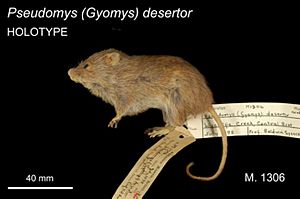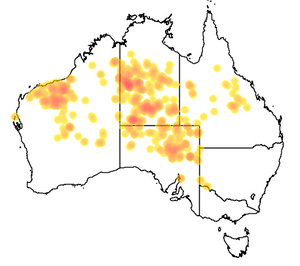Desert mouse facts for kids
Quick facts for kids Desert mouse |
|
|---|---|
 |
|
| Pseudomys desertor specimen. Type: holotype. Australian Museum. | |
| Conservation status | |
| Scientific classification | |
| Genus: |
Pseudomys
|
| Species: |
desertor
|
 |
|
| Pseudomys desertor occurrence records | |
The desert mouse (Pseudomys desertor) is a small rodent that lives in Australia. It's also sometimes called the brown desert mouse. This mouse is special because it's only found in Australia. The first desert mouse was found by a scientist named Gerard Krefft way back in 1856-57.
Contents
What Does the Desert Mouse Look Like?
The desert mouse has fur that is a bright chestnut brown on its back. It also has longer, darker hairs that make its fur look a bit spiky. Its belly fur is a lighter grey-brown color.
Its tail looks a bit scaly and has two slightly different colors. The tail is usually about the same length as its head and body, or a little shorter. A cool thing about the desert mouse is its pale orange ring around its eyes. This eye-ring can help tell it apart from other similar mice.
A desert mouse usually measures about 70 to 105 millimeters (about 2.7 to 4.1 inches) from its head to its body. Its tail is typically 67 to 103 millimeters (about 2.6 to 4 inches) long. These mice weigh between 15 and 35 grams (about 0.5 to 1.2 ounces).
Where Do Desert Mice Live?
The desert mouse lives all over the dry, arid parts of Australia. You can also find them in the dry savannah areas of northern Queensland.
They like to live in places like sand dunes that have spinifex grass. They also live on rocky hillsides. These mice dig shallow burrows in these areas to make their homes.
Scientists have found old bones of desert mice in many places. These include Cape Range National Park and the Nullarbor Plain in Western Australia. They have also been found in the northern Flinders Ranges of South Australia and near Lake Victoria in New South Wales. These old findings, along with where they live today, show that desert mice used to live in even more places across dry Australia.
How Do Desert Mice Behave?
What Do Desert Mice Eat?
Desert mice mostly eat leaves and shoots from plants. This makes them folivores. But when there aren't many leaves or shoots around, they will also eat seeds and small bugs. Studies have shown that desert mice don't need much water to survive.
How Do Desert Mice Have Babies?
Desert mice have babies very often. They have a high reproduction rate, which means their populations can grow quickly after good rainfall. Female mice are ready to have babies in a cycle that lasts 7 to 9 days.
A mother desert mouse carries her babies for about 27 to 28 days. On average, she will have three pups in a litter. These young mice will be ready to have their own babies when they are about ten weeks old.
What Threats Do Desert Mice Face?
Desert mice seem to be less common in areas that have been affected by fires or where a lot of animals graze. Other dangers come from animals that have been brought to Australia by people. For example, foxes and feral cats hunt them.
They also have to compete for food and space with other animals. The house mouse (Mus musculus) is one such competitor. In Queensland, new types of grasses that are not native to Australia can also change their habitat.
See also
 In Spanish: Pseudomys desertor para niños
In Spanish: Pseudomys desertor para niños



